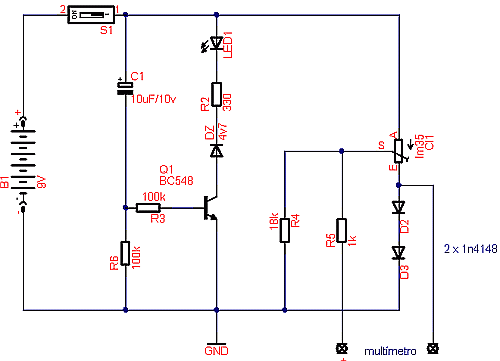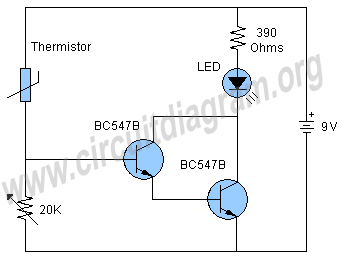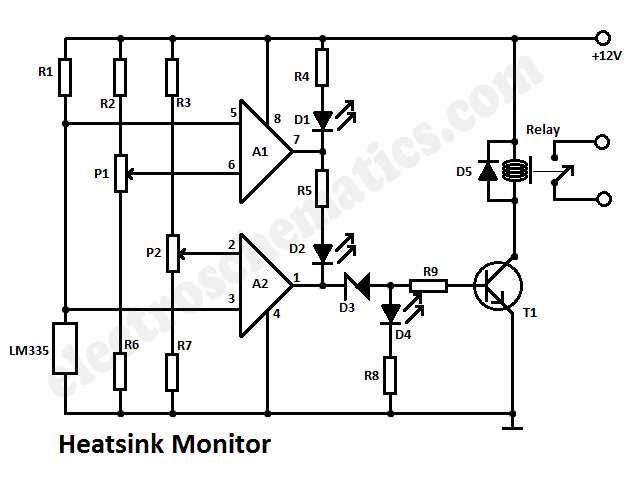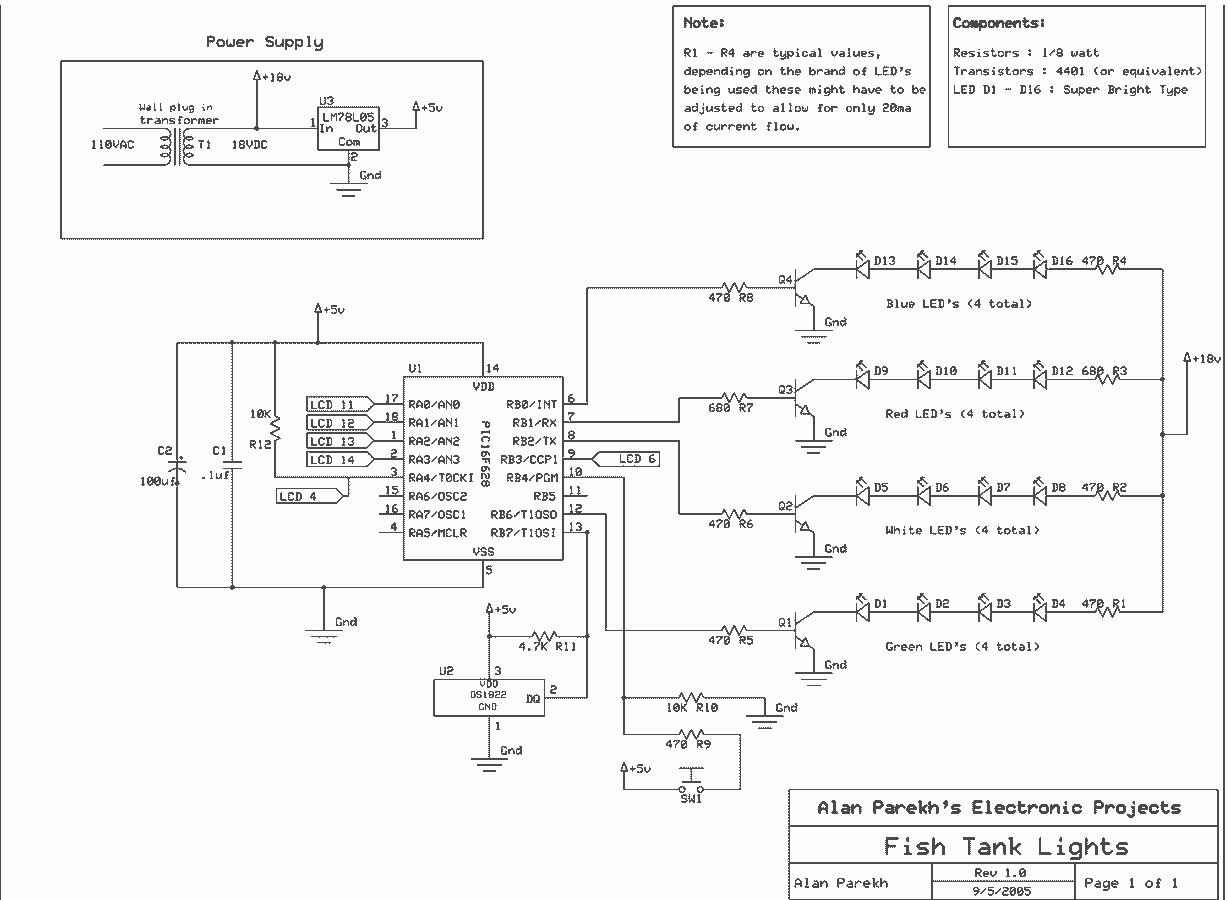
8 NC temperature adjustment
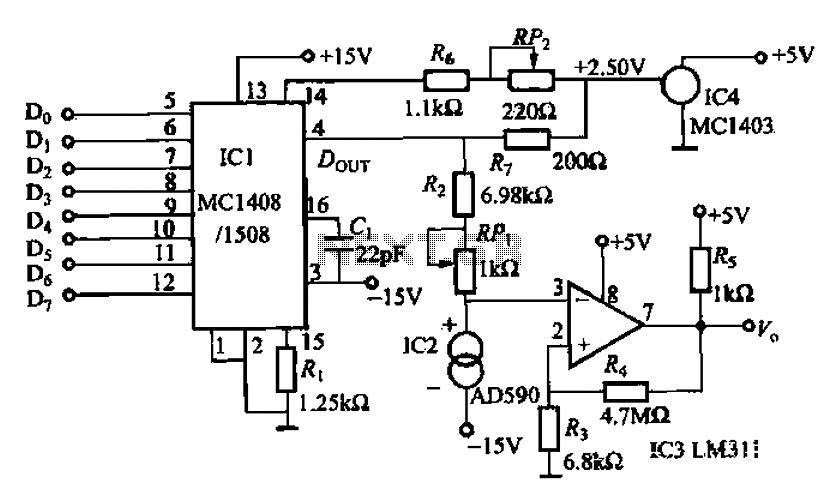
An 8 NC temperature adjusting circuit is presented, primarily composed of a D/A converter, a reference power supply, amplification components, temperature sensors, and other necessary elements. This circuit regulates the temperature within a range of 0-51°C and is suitable for use in solar shower systems with intelligent temperature control capabilities. The circuit divides the temperature range into 256 increments, allowing for a step change of 0.2°C. The reference voltage source is provided by IC4, while the output voltage is adjusted by RP2 and R6, which are connected to ICl and IC1 to generate a reference voltage. The D/A converter IC1 receives an 8-bit digital signal from a digital output device and converts it into an analog signal at its output pin. After passing through resistors R2 and RPi, the output from the temperature sensor AD590 is amplified by operational amplifier IC3, resulting in a significant analog output signal, Vo. The circuit also incorporates hysteresis to ensure stable output voltage.
The 8 NC temperature adjusting circuit is designed to maintain precise temperature control, making it ideal for applications such as solar showers where consistent water temperature is essential. The D/A converter (IC1) plays a critical role in translating digital commands from a microcontroller or other digital control systems into an analog voltage that can be used to drive heating elements or other temperature regulation devices.
The temperature sensors, which may include thermistors or thermocouples, provide real-time feedback on the current temperature, allowing the circuit to adjust the output accordingly. The reference voltage generated by IC4 ensures that the D/A converter operates within specified limits, providing stability and accuracy in the output signal.
The operational amplifier (IC3) amplifies the output from the temperature sensor (AD590) to ensure that the signal is strong enough for further processing. The use of resistors R2 and RPi allows for fine-tuning of the gain and helps to set the output voltage range. The hysteresis feature is crucial in preventing oscillations in the output voltage, thereby enhancing the reliability of the temperature regulation system.
Overall, this circuit exemplifies a sophisticated approach to temperature management in solar heating applications, leveraging digital and analog components to achieve precise control and performance.8 NC temperature adjusting circuit shown, which is mainly composed of D/A converter, a reference power supply, amplification, temperature sensors and other components. This cir cuit controls the temperature in the range of 0-5l, can be used in solar shower intellectual equipment capable of temperature control. 0-51qC into the circuit 28 256 aliquots to step change 0.2. IC4 reference voltage source, 2.SV output voltage by RP2, R6 added ICl ~ feet IC1 to provide a reference voltage.
D/A converter IC1 accepted from other 8-bit digital signal of the digital output device, the internal conversion into an analog signal output from the pin. After R2, RPi and AD590 output of the operational amplifier IC3 superimposed evacuations put large, the analog output signal vo.
Marrow role is to produce a certain output voltage hysteresis.
The 8 NC temperature adjusting circuit is designed to maintain precise temperature control, making it ideal for applications such as solar showers where consistent water temperature is essential. The D/A converter (IC1) plays a critical role in translating digital commands from a microcontroller or other digital control systems into an analog voltage that can be used to drive heating elements or other temperature regulation devices.
The temperature sensors, which may include thermistors or thermocouples, provide real-time feedback on the current temperature, allowing the circuit to adjust the output accordingly. The reference voltage generated by IC4 ensures that the D/A converter operates within specified limits, providing stability and accuracy in the output signal.
The operational amplifier (IC3) amplifies the output from the temperature sensor (AD590) to ensure that the signal is strong enough for further processing. The use of resistors R2 and RPi allows for fine-tuning of the gain and helps to set the output voltage range. The hysteresis feature is crucial in preventing oscillations in the output voltage, thereby enhancing the reliability of the temperature regulation system.
Overall, this circuit exemplifies a sophisticated approach to temperature management in solar heating applications, leveraging digital and analog components to achieve precise control and performance.8 NC temperature adjusting circuit shown, which is mainly composed of D/A converter, a reference power supply, amplification, temperature sensors and other components. This cir cuit controls the temperature in the range of 0-5l, can be used in solar shower intellectual equipment capable of temperature control. 0-51qC into the circuit 28 256 aliquots to step change 0.2. IC4 reference voltage source, 2.SV output voltage by RP2, R6 added ICl ~ feet IC1 to provide a reference voltage.
D/A converter IC1 accepted from other 8-bit digital signal of the digital output device, the internal conversion into an analog signal output from the pin. After R2, RPi and AD590 output of the operational amplifier IC3 superimposed evacuations put large, the analog output signal vo.
Marrow role is to produce a certain output voltage hysteresis.
